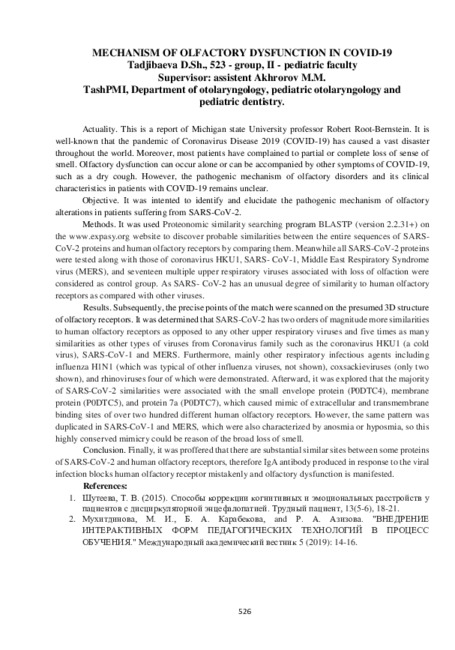
526
MECHANISM OF OLFACTORY DYSFUNCTION IN COVID-19
Tadjibaeva D.Sh., 523 - group, II - pediatric faculty
Supervisor: assistent Akhrorov M.M.
TashPMI, Department of otolaryngology, pediatric otolaryngology and
pediatric dentistry.
Actuality. This is a report of Michigan state University professor Robert Root-Bernstein. It is
well-known that the pandemic of Coronavirus Disease 2019 (COVID-19) has caused a vast disaster
throughout the world. Moreover, most patients have complained to partial or complete loss of sense of
smell. Olfactory dysfunction can occur alone or can be accompanied by other symptoms of COVID-19,
such as a dry cough. However, the pathogenic mechanism of olfactory disorders and its clinical
characteristics in patients with COVID-19 remains unclear.
Objective. It was intented to identify and elucidate the pathogenic mechanism of olfactory
alterations in patients suffering from SARS-CoV-2.
Methods. It was used
Proteonomic similarity searching
program
BLASTP (version 2.2.31+) on
the www.expasy.org website to discover probable similarities between the entire sequences of SARS-
CoV-2 proteins and human olfactory receptors by comparing them. Meanwhile all SARS-CoV-2 proteins
were tested along with those of coronavirus HKU1, SARS- CoV-1, Middle East Respiratory Syndrome
virus (MERS), and seventeen multiple upper respiratory viruses associated with loss of olfaction were
considered as control group. As SARS- CoV-2 has an unusual degree of similarity to human olfactory
receptors as compared with other viruses.
Results. Subsequently, the precise points of the match were scanned on the presumed 3D structure
of olfactory receptors. It was determined that
SARS-CoV-2 has two orders of magnitude more similarities
to human olfactory receptors as opposed to any other upper respiratory viruses and five times as many
similarities as other types of viruses from Coronavirus family such as the coronavirus HKU1 (a cold
virus), SARS-CoV-1 and MERS. Furthermore, mainly other respiratory infectious agents including
influenza H1N1 (which was typical of other influenza viruses, not shown), coxsackieviruses (only two
shown), and rhinoviruses four of which were demonstrated. Afterward, it was explored that the majority
of SARS-CoV-2 similarities were associated with the small envelope protein (P0DTC4), membrane
protein (P0DTC5), and protein 7a (P0DTC7), which caused mimic of extracellular and transmembrane
binding sites of over two hundred different human olfactory receptors. However, the same pattern was
duplicated in SARS-CoV-1 and MERS, which were also characterized by anosmia or hyposmia, so this
highly conserved mimicry could be reason of the broad loss of smell.
Conclusion.
Finally, it was proffered that there are substantial similar sites between some proteins
of SARS-CoV-2 and human olfactory receptors, therefore IgA antidiv produced in response to the viral
infection blocks human olfactory receptor mistakenly and olfactory dysfunction is manifested.
References:
1.
Шутеева, Т. В. (2015). Способы коррекции когнитивных и эмоциональных расстройств у
пациентов с дисциркуляторной энцефалопатией. Трудный пациент, 13(5-6), 18-21.
2.
Мухитдинова, М. И., Б. А. Карабекова, and Р. А. Азизова. "ВНЕДРЕНИЕ
ИНТЕРАКТИВНЫХ ФОРМ ПЕДАГОГИЧЕСКИХ ТЕХНОЛОГИЙ В ПРОЦЕСС
ОБУЧЕНИЯ." Международный академический вестник 5 (2019): 14-16.






